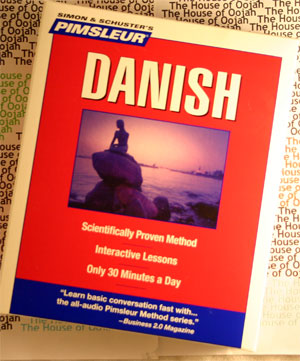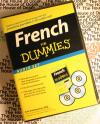Pimsleur Danish 5 Audio CDs- Learn to Speak Danish
Pimsleur Danish - Audio CDAudio CDs play on Car/Portable/Home CD player |
 |
Pimsleur Danish - 5 Audio CDBrand New : 5 CDs HEAR IT, LEARN IT, SPEAK IT About the Danish Language:Danish is one of the North Germanic languages (also called Scandinavian languages), a sub-group of the Germanic branch of the Indo-European languages. It is spoken by around 6 million people, mainly in Denmark; the language is also used by the 50,000 Danes in the northern parts of Schleswig-Holstein in Germany, where it holds the status of minority language. Danish also holds official status and is a mandatory subject in school in the Danish territories of Greenland and the Faroe Islands, which now enjoy limited autonomy. In Iceland and Faroe Islands, Danish is, alongside English, a compulsory foreign language taught in schools. In North and South America there are Danish language communities in Argentina, the U.S. and Canada. Classification and related languages Danish, together with Swedish, derives from the East Nordic dialect group, while Norwegian is classified as a West Nordic language together with Faroese and Icelandic. A more recent classification based on mutual intelligibility separates modern spoken Scandinavian in two groups: Southern Scandinavian, which is Danish, and Northern Scandinavian, consisting of Norwegian and Swedish. Icelandic and Faroese is placed in a separate Insular Scandinavian. Written Danish and Norwegian Bokmål are particularly close, though the phonology and prosody make them differ somewhat. Proficient speakers of any of the three languages can understand the others, though studies have shown that speakers of Norwegian generally understand both Danish and Swedish far better than Swedes or Danes understand each other. Both Swedes and Danes also understand Norwegian better than they understand each other's languages.[1] Due to its proximity with German, Fan Noli, linguist and translator of Ibsen’s works, said that “those who know German can learn Danish in fifteen days”.[1] History In the 8th century, the common Germanic language of Scandinavia, Proto-Norse, had undergone some changes and evolved into Old Norse. This language began to undergo new changes that did not spread to all of Scandinavia, which resulted in the appearance of two similar dialects, Old West Norse (Norway and Iceland) and Old East Norse (Denmark and Sweden). Old East Norse is in Sweden called Runic Swedish and in east Denmark Runic Danish, but until the 12th century, the dialect was roughly the same in the two countries. The dialects are called runic due to the fact that the main body of text appears in the runic alphabet. Unlike Proto-Norse, which was written with the Elder Futhark alphabet, Old Norse was written with the Younger Futhark alphabet, which only had 16 letters. Due to the limited number of runes, some runes were used for a range of phonemes, such as the rune for the vowel u which was also used for the vowels o, ø and y, and the rune for i which was also used for e. A change that separated Old East Norse (Runic Swedish/Danish) from Old West Norse was the change of the diphthong æi (Old West Norse ei) to the monophthong e, as in stæin to sten. This is reflected in runic inscriptions where the older read stain and the later stin. There was also a change of au as in dauðr into ø as in døðr. This change is shown in runic inscriptions as a change from tauþr into tuþr. Moreover, the øy (Old West Norse ey) diphthong changed into ø as well, as in the Old Norse word for "island". Some famous authors of works in Danish are existential philosopher Søren Kierkegaard, prolific fairy tale author Hans Christian Andersen, and playwright Ludvig Holberg. Three 20th century Danish authors have become Nobel Prize laureates in Literature: Karl Adolph Gjellerup and Henrik Pontoppidan (joint recipients in 1917) and Johannes Vilhelm Jensen (awarded 1944). Danish was once widely spoken in the northeast counties of England. Many Danish derived words such as gate (gade) for street, still survive in Yorkshire and other parts of eastern England colonized by Danish Vikings. The city of York was once the Danish settlement of Jorvik. The first printed book in Danish dates from 1495. The first complete translation of the Bible in Danish was published in 1550. Geographical distribution Danish is the national language of Denmark, one of two official languages of Greenland (the other is Greenlandic), and one of two official languages of the Faroes (the other is Faroese). In addition, there is a small community of Danish speakers in Southern Schleswig, the portion of Germany bordering Denmark, where it is an officially recognized regional language, just as German is north of the border. Furthermore, Danish is one of the official languages of the European Union and one of the working languages of the Nordic Council. Under the Nordic Language Convention, citizens of the Nordic countries speaking Danish have the opportunity to use their native language when interacting with official bodies in other Nordic countries without being liable to any interpretation or translation costs. There is no law stipulating an official language for Denmark, making Danish the de facto language only. The Code of Civil Procedure does, however, lay down Danish as the language of the courts. Since 1997 public authorities have been obliged to observe the official spelling by way of the Orthography Law. Dialects Standard Danish (rigsdansk) is the language based on dialects spoken in and around the capital of Copenhagen. Unlike Swedish and Norwegian, Danish does not have more than one regional speech norm. More than 25% of all Danish speakers live in the metropolitan area and most government agencies, institutions and major businesses keep their main offices in Copenhagen, something that has resulted in a very homogeneous national speech norm. In contrast, though Oslo (Norway) and Stockholm (Sweden) are quite dominant in terms of speech standards, cities like Bergen, Gothenburg and the Malmö-Lund region are large and influential enough to create secondary regional norms, making the standard language more varied than is the case with Danish. The general agreement is that Standard Danish is based on a form of Copenhagen dialect, but the specific norm is, as with most language norms, difficult to pinpoint for both laypeople and scholars. Historically Standard Danish emerged as a compromise between the dialect of Zealand and Scania. The first layers of it can be seen in east Danish provincial law texts such as Skånske Lov, just as we can recognize west Danish in laws from the same ages in Jyske Lov. Despite the relative cultural monopoly of the capital and the centralised government, the divided geography of the country allowed distinct rural dialects to flourish during the centuries. Such "genuine" dialects were formerly spoken by a vast majority of the population, but have declined much since the 1960s. They still exist in communities out on the countryside, but most speakers in these areas generally speak a regionalized form of Standard Danish, when speaking with one who speaks to them in that same standard. Usually an adaptation of the local dialect to rigsdansk is spoken, though code-switching between the standard-like norm and a distinct dialect is common. Danish is divided into three distinct dialect groups: * Eastern Danish (østdansk), including the Bornholm, Scanian and Halland dialects Historically, Eastern Danish includes what is occasionally considered Southern Swedish dialects. The background for this lies in the loss of the originally Danish provinces Blekinge, Halland and Scania to Sweden in 1658. The island Bornholm in the Baltic also belongs to this group, but remained Danish. A few generations ago, the classical dialects spoken in the southern Swedish provinces could still be argued to be more Eastern Danish than Swedish, being similar to the dialect of Bornholm. Today influx of Standard Swedish vocabulary has generally meant that Scanian and Bornholmish are closer to the modern national standards than to each other[citation needed]. The Bornholm dialect has also maintained to this day many ancient features, such as a distinction between three grammatical genders, which the central Island Danish dialects gave up during the 20th Century. Standard Danish has two genders, and Western Jutlandic only one, similar to English. Today, Standard Danish is most similar to the Island Danish dialect group. Sound system The sound system of Danish is in many ways unique among the world's languages. It is quite prone to considerable reduction and assimilation of both consonants and vowels even in very formal standard language. A rare feature is the presence of a prosodic feature called stød in Danish (lit. "push; thrust"). This is a form of laryngealization or creaky voice, only occasionally realized as a full glottal stop (especially in emphatic pronunciation). It can be the only distinguishing feature between certain words, thus creating minimal pairs (e.g. bønder "peasants" with stød vs. bønner "beans" without). The distribution of stød in the lexicon is clearly related to the distribution of the common Scandinavian tonal word accents found in most dialects of Norwegian and Swedish, including the national standard languages. Most linguists today believe that stød is a development of the word accents, rather than the other way round[citation needed]. Some have theorized it emerged from the overwhelming influence of Low German in medieval times, having flattened the originally Nordic melodic accent, but stød is absent in most southern Danish dialects where Low German impact would have been the greatest. Stød generally occurs in words that have "accent 1" in Swedish and Norwegian and that were monosyllabic in Old Norse, while no-stød occurs in words that have "accent 2" in Swedish and Norwegian and that were polysyllabic in Old Norse. Unlike the neighboring Continental Scandinavian languages, the prosody of Danish does not have phonemic pitch. Stress is phonemic and distinguishes words such as billigst ['bilist] "cheapest" and bilist [bi'list] "car driver".
|
Pimsleur Danish - Audio CD |


 0 Items (Empty)
0 Items (Empty)


